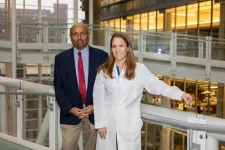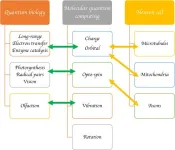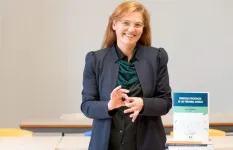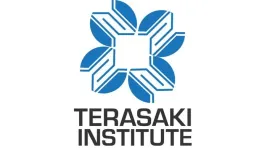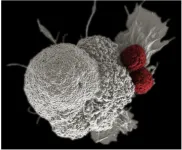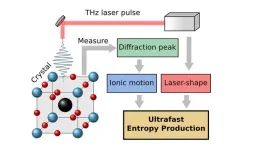(Press-News.org) Simply asking patients to get the flu vaccine, and combining it with helpful video and print messages, is enough to persuade many who visit emergency departments to roll up their sleeves, according to a new study led by UC San Francisco.
Researchers found a 32% vaccine uptake in patients who were asked if they’d be interested in getting the flu shot and told their health providers would be informed. They saw a 41% uptake for those who were asked about receiving a flu shot and received a pamphlet, watched a three-minute video of a physician with a similar ethnic background discussing the vaccine and were told about the benefits of the vaccine.
The study published March 26, 2024 in NEJM Evidence.
The researchers say this type of systematic approach could lead to more underserved people receiving vaccines, especially those whose primary health care occurs in emergency departments.
Flu can be fatal
Flu leads to considerable mortality in the United States – annual death rates are typically in the tens of thousands, especially when combined with pneumonia – but vaccination is particularly low among underserved populations and those whose primary care occurs in emergency departments. Such patients often face general vaccine hesitancy or a lack of opportunities for the flu shot.
“This research arose from our desire to address the health disparities that we see every day in our emergency department, especially among homeless persons, the uninsured and immigrant populations,” said first author, Robert M. Rodriguez, MD, a professor of Emergency Medicine with the UCSF School of Medicine.
Investigators in the study created flu vaccine messaging – including a brief video, flyer and a scripted health provider question, “Would you be willing to accept the influenza vaccine?” – and assessed their effectiveness among nearly 800 patients in five cities: San Francisco, Houston, Philadelphia, Seattle and Durham, North Carolina. The median age was 46. More than half the participants in the trial were Black or Latino, 16 % lacked health insurance, nearly a third had no primary care and 9% were homeless or living in severely inadequate housing. These demographic characteristics are similar to patient populations often served by urban emergency departments.
The researchers designed the clinical trial to span a single flu season between Oct. 2022 and Feb. 2023.
“Overall, our study adds to the growing body of knowledge showing that a number of important public health interventions can and should be delivered to underserved populations in emergency departments,” said Rodriguez, whose previous research has found the effectiveness of delivering similar COVID-19 vaccine messaging to emergency department patients.
Co-authors: From UCSF, co-authors are Melanie F. Molina, MD; James Ford, MD; Mireya I. Arreguin; Cecilia Lara Chavez; and Dave V. Glidden, PhD. See paper for other co-authors.
Funding: The study was funded by the National Institute of Allergy and Infectious Diseases (RO1 AII66967-01).
About UCSF Health: UCSF Health is recognized worldwide for its innovative patient care, reflecting the latest medical knowledge, advanced technologies and pioneering research. It includes the flagship UCSF Medical Center, which is a top-ranked specialty hospital, as well as UCSF Benioff Children’s Hospitals, with campuses in San Francisco and Oakland; Langley Porter Psychiatric Hospital; UCSF Benioff Children’s Physicians; and the UCSF Faculty Practice. These hospitals serve as the academic medical center of the University of California, San Francisco, which is world-renowned for its graduate-level health sciences education and biomedical research. UCSF Health has affiliations with hospitals and health organizations throughout the Bay Area. Visit https://www.ucsfhealth.org/. Follow UCSF Health on Facebook or on Twitter
###
Follow UCSF
ucsf.edu | Facebook.com/ucsf | Twitter.com/ucsf | YouTube.com/ucsf
END
Just ask: patients in the ER are willing to get a flu shot
2024-03-26
ELSE PRESS RELEASES FROM THIS DATE:
Collaborative University of Cincinnati Cancer Center team opens Phase 2 brain tumor trial
2024-03-26
A multidisciplinary team of University of Cincinnati Cancer Center researchers have opened a Phase 2 clinical trial to test a new combination treatment for glioblastomas (GBM), the most deadly form of brain tumors.
The team, led by UC’s Pankaj Desai, PhD, and Trisha Wise-Draper, MD, PhD, has been awarded a Catalyst Research Award from the Dr. Ralph and Marian Falk Medical Research Trust to move the trial forward.
Study background
Difficult to diagnose at early stages, GBMs are aggressive brain tumors that become symptomatic once the tumor is substantial. Current treatments include ...
Silicon spikes take out 96% of virus particles
2024-03-26
An international research team led by RMIT University has designed and manufactured a virus-killing surface that could help control disease spread in hospitals, labs and other high-risk environments.
The surface made of silicon is covered in tiny nanospikes that skewer viruses on contact.
Lab tests with the hPIV-3 virus – which causes bronchitis, pneumonia and croup – showed 96% of the viruses were either ripped apart or damaged to the point where they could no longer replicate to cause infection.
These impressive results, featured on the cover of top nanoscience journal ACS Nano, show the material’s promise ...
New research area promotes both quantum computing and cognitive science
2024-03-26
Diving deep into quantum biology or cognitive science alone is challenging enough. That being said, a research team recently wrote a review article highlighting molecular quantum computing, a newly emerged research area that is likely to push the research boundaries of both. The review was published Feb. 21 in Intelligent Computing, a Science Partner Journal.
Future theoretical breakthroughs may be achieved by connecting molecular quantum computing, the bridge research area, with cognitive science and quantum ...
Among deaf people, women have higher levels of personal growth
2024-03-26
One of the features of the deaf community is that it is highly diverse. As well as including people of different ages and genders, the members of the community do not all share the same type of deafness or form of communication. Firstly, the time of onset of deafness and the degree of hearing loss vary greatly. And secondly, not everybody uses sign and oral language in the same way. All these aspects have a bearing on the well-being of deaf people. However, few studies specifically analyse the effect of each one.
The PhD thesis, defended by Amaia Jauregi-Orbe at the Faculty ...
Severe hurricanes boost influx of juveniles and gene flow in a coral reef sponge
2024-03-26
Named for its ropy-looking long branches, Aplysina cauliformis, a coral reef sponge, provides a critical 3D habitat for marine organisms and helps to stabilize the foundation of coral reefs. However, these upright branching sponges are highly susceptible to breaking during storms, which increases sponge fragmentation and contributes to population clonality and inbreeding.
Many sponges can survive severe damage and undergo frequent fragmentation, which is considered a mechanism for asexual reproduction. While fragmentation is a commonly utilized reproductive strategy in rope sponges, they also can reproduce sexually by producing larvae. How and whether they recolonize following ...
Terasaki Institute for Biomedical Innovation catalyzes healthcare revolution with launch of four cutting-edge startups
2024-03-26
LOS ANGELES – (3/26/24) - In a landmark move for biomedical progress, the Terasaki Institute for Biomedical Innovation (TIBI) today unveiled the launch of four pioneering startup companies. These ventures represent a strategic leap forward in TIBI's commitment to transforming healthcare through innovation. By harnessing the institute's groundbreaking research in biomaterials, micro-needles, organoids, tissue engineering, and advanced biosensing, these startups are poised to tackle some of the most pressing health challenges ...
Faux reefs for coastal protection
2024-03-26
Engineers have designed a modular artificial reef that can dissipate wave energy far better than natural coral reefs, according to a study. Sixty percent of the world’s coral reefs are under threat from rising ocean temperatures, overfishing, or coastal development. At the same time, climate change is leading to sea level rise, frequent high-tide flooding, and powerful storm surges. Artificial reefs can help protect coastal infrastructure from storms as well as provide habitat for marine organisms. Michael Triantafyllou and colleagues proposed and tested an architected cellular reef structure ...
Mount Sinai study calls for major changes in the way people with comorbidities are selected by physicians for lung cancer screening
2024-03-26
A Medicare policy requiring primary care providers (PCPs) to share in the decision-making with patients on whether to proceed with lung cancer screening is fraught with confusion and lack of evidence-based information, and may actually be undermining the purpose for which it was created, Mount Sinai researchers say.
In their study, published in Annals of Family Medicine, the team reported that the policy, enacted nearly 10 years ago to encourage the use of lung cancer screening, is in urgent need of new ...
Smart maneuver: Epstein-Barr virus hijacks host genome boosting nasopharyngeal carcinoma
2024-03-26
Nasopharyngeal carcinoma (or NPC) is a rare type of cancer affecting the epithelial tissue of the nasopharynx, the upper part of the throat behind the nasal cavity. Among the three main subtypes of NPC, non-keratinizing undifferentiated squamous carcinoma is endemic to the regions of Southern China and Southeast Asia, with a strong association with Epstein-Barr virus (or EBV) infection. EBV, also known as human tumor virus, is a double-stranded DNA virus that is associated with various cancers, such as Burkitt lymphoma, T-cell lymphoma, and gastric cancer. EBV genomes mostly survive autonomously as episomes or extrachromosomal ...
New method to measure entropy production on the nanoscale
2024-03-26
Entropy, the amount of molecular disorder, is produced in several systems but cannot be measured directly. An equation developed by researchers at Chalmers University of Technology and Heinrich Heine University Düsseldorf, now sheds new light on how entropy is produced on a very short time scale in laser excited materials.
“New computational models give us new research opportunities. Extending thermodynamics for ultrashort excitations will provide novel insights into how materials function on the nanoscale,” says Matthias Geilhufe, Assistant Professor ...
